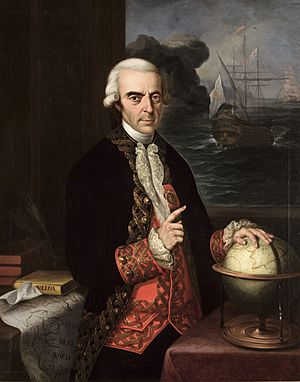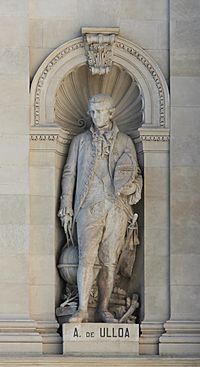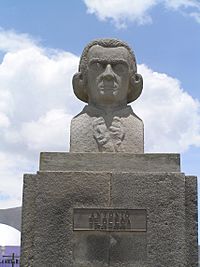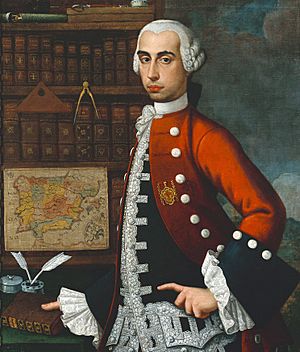Antonio de Ulloa facts for kids
Quick facts for kids
The Most Excellent
Antonio de Ulloa
|
|
|---|---|

Posthumous portrait by Andrés Cortés (1856)
|
|
| Born |
Antonio de Ulloa y de la Torre-Giralt
12 January 1716 |
| Died | 3 July 1795 (aged 79) |
| Nationality | Spanish |
| Alma mater | Real Compañía de Guardias Marinas (Spanish Naval Academy) |
| Spouse(s) | Francisca Ramírez de Laredo |
| Scientific career | |
| Fields | Astronomy, metallurgy, natural history |
| 1st Spanish Governor of Louisiana | |
| In office 1763–1768 |
|
| Monarch | Charles III |
| Preceded by | Charles Philippe Aubry as French Colonial Governor |
| Succeeded by | Charles Philippe Aubry (Acting) |
| Military service | |
| Allegiance | |
| Branch/service | Spanish Navy |
| Rank | Vice-admiral |
Antonio de Ulloa y de la Torre-Giralt (1716–1795) was an important Spanish naval officer, scientist, and administrator. He was known for his many discoveries and observations. At just 19, he joined a major French science trip to what is now Ecuador. This trip lasted over eight years. During this time, Ulloa made many important notes about stars, nature, and people in South America.
His reports made him famous worldwide as a leading scientist. He was the first to describe the metal platinum in a published report. Platinum was later found to be a new chemical element. Ulloa became a member of the Royal Society of London in 1746. He also joined the Royal Swedish Academy of Sciences in 1751. He served the Spanish king as a governor and later became a vice-admiral in the Spanish Navy.
Contents
Life and Discoveries
Early Life and Education
Antonio de Ulloa was born in Seville, Spain, in 1716. His family was well-known and very smart. His father, Bernardo de Ulloa, wrote important books about money and business. His brother, Fernando, became a famous engineer.
Antonio decided to join the navy. When he was 13, he sailed from Cádiz on a large ship called the San Luis. He traveled to Cartagena de Indias in what is now Colombia. After this trip, he joined the Spanish Naval Academy in 1733.
Exploring South America
In 1735, the French Academy of Sciences planned a big science trip. They wanted to go to Quito, in modern-day Ecuador. Their goal was to measure the Earth's shape. This would help scientists decide if Isaac Newton's ideas about gravity were correct.
Ulloa and another young officer, Jorge Juan, were chosen to go with the French team. This was a very important job for Spain. The trip was difficult at first. Local Spanish leaders did not always cooperate. Ulloa and Juan even had to hide in a church at one point.
Ulloa traveled across Peru from 1736 to 1744. He made many notes about stars, nature, and the people he met. During his travels, he found a metal he called platina, meaning "little silver." He saw it while checking gold mining in Chocó, which is now part of Colombia. This metal was later identified as platinum. Because of this, Ulloa is often called the discoverer of platinum.
The results of this trip proved that Isaac Newton's ideas about the Earth's shape were right. This was a big win for Newton's science.
Returning to Spain
In 1745, Ulloa and Jorge Juan finished their work. They decided to sail on different ships to make sure their important notes and samples were safe. Ulloa's ship was captured by the British Navy. He was taken to England as a prisoner of war.
However, in England, important scientists quickly became his friends. He was elected a Fellow of the Royal Society of London in December 1746. Thanks to the help of the Royal Society's president, Martin Folkes, Ulloa was set free. He was allowed to return to Spain.
In 1749, Ulloa published his book, Relación histórica del viaje a la América Meridional. This book gave a detailed description of South America. It talked about its geography, people, and nature. It was later translated into English as A Voyage to South America.
Ulloa and Juan also wrote a secret report for the Spanish king. It talked about problems in the Spanish lands in South America. They wrote about corruption and how Native Americans were treated unfairly. This report was not published until 1826, after South American countries became independent.
Ulloa became a well-known scientist around the world. He helped start Spain's first natural history museum. He also helped create the first metal research lab and an observatory for studying stars. In 1751, he became a member of the Royal Swedish Academy of Sciences.
Serving as an Administrator

Ulloa went back to South America in 1758. He became the governor of Huancavelica in Peru. He also managed the quicksilver (mercury) mines there. Mercury was very important for getting silver and gold out of the ground. Ulloa tried to stop corruption in the local government. But he was not successful and asked to leave his job in 1764.
After France lost the Seven Years' War to Britain, France gave its lands in North America to Spain. Ulloa was chosen to be the first Spanish governor of Louisiana. He arrived in New Orleans in 1766. However, the French colonists there did not want Spanish rule. This led to the Louisiana Rebellion of 1768. Ulloa and his pregnant wife had to leave the city. The Spanish king later sent more soldiers to stop the rebellion.
Between 1776 and 1778, Ulloa helped organize a Spanish fleet. This was during the American Revolutionary War, when Spain helped the American colonies fight Britain. He also helped build a shipyard in Veracruz, Mexico.
Later Years and Legacy
In 1768, Ulloa married Francisca Ramírez de Laredo in New Orleans. She came from a high-society family in Lima. They had six children. One of their sons, Francisco Javier de Ulloa, later became Spain's Minister of Marine.
In 1779, Ulloa was promoted to vice-admiral. He took part in the Great Siege of Gibraltar. He was later cleared of any wrongdoing during the siege. Ulloa became the chief of operations for the Spanish Navy. He held this important position until he died in 1795.
Legacy

Antonio de Ulloa is remembered for his work on the Earth's shape and his early reports on platinum. He is also known for describing a weather event called "Ulloa's halo." This is a faint, white ring of light that you might sometimes see in fog when the sun shines through. It's like a rainbow but made by fog droplets.
The secret report Ulloa wrote with Jorge Juan, called Noticias secretas de América, was published in 1826. It talked about many problems in the Spanish colonies. It described corruption and how officials treated the Native American people. This report has been a topic of discussion among historians ever since.
Tributes
- In 2016, Spain honored Antonio de Ulloa by issuing a special postage stamp.
See also
 In Spanish: Antonio de Ulloa para niños
In Spanish: Antonio de Ulloa para niños


